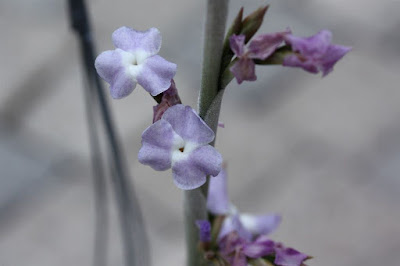Tillandsia duratii is native to the dry forests of Bolivia, the eastern areas of Paraguay, Brazil, Uruguay and northern Argentina. It is found at various altitudes ranging from 200 to over 1300 meters, almost 3000 meters for saxatilis variety...
Tillandsia duratii also called as Anoplophytum duratii, Phytarrhiza circinalis, Phytarrhiza duratii, Tillandsia circinalis, Tillandsia duratii var. duratii, Tillandsia gigantea, Tillandsia revoluta, Wallisia duratii, is a species of the genus Tillandsia. This species was described by Roberto de Visiani in 1841.
IDENTIFY TILLANDSIA DURATII
Tillandsia duratii is native to the dry forests of Bolivia, the eastern areas of Paraguay, Brazil, Uruguay and northern Argentina. It is found at various altitudes ranging from 200 to over 1300 meters, almost 3000 meters for saxatilis variety.
It is a perennial epiphyte bromeliad, which reaching the height of 60 to 100 cm, with a rosette form from the numerous, yellow-green, linear and sessile with entire margins and parallel venation, densely covered by grey hairs leaves that able to bend backwards as the plant grows.
This species blooms from a linear, flattened, tight, scaly and green inflorescence with panicles of purple (may be pure white, dark violet, yellow, and peach) funnel-shaped, very fragrant, non-tubular, 2.5 cm wide flowers. Each flower has three large, mostly lilac or purple petals that are free, not connated in a tube. The throat of the corolla is white. The duration of the blooms varies among plants and even between the bract and flower, with the bract lingering for much longer than the petals and stamens that emerge from it.
TILLANDSIA DURATII CARE AND CULTURE
Cultural information should only be used as a guide, and should be to be adapted to suit you. Your physical location; where you grow your plants, how much time you have to devote to their care, and many other factors, will need to be taken into account. Only then can you decide on the cultural methods that best suit you and your plants.
Light:
The main condition for ensuring optimal development is light. Light must be intense, but Tillandsia duratii should not be exposed to direct sunlight. Although some specimens can also be adapted to full sun exposures, adaptation to these conditions will lead to leaves damaged by burns.
During the dry period, the plants can be placed outdoors, but when the prolonged rains begin, it will be better to protect it.
Temperature:
The required temperature ranging from 10 to 32°C. This air plants should not face the night temperatures below -7 ° C, especially if it is wet. The plants can even faced temperatures close to 0 ° C (sheltered and dry) for a few hours without damage, but it should avoid in cultivation. The temperature in winter should be 15°C.
Mounting:
This species can grow suspended (without any support) or grow as epiphyte. When cultivated as an epiphyte the plants are mounted on a piece of bark or a branch and the roots are wrapped in Sphagnum moss. Place the plant very close to a window when growing indoors in the winter and preferably out in the summer.
Watering:
Tillandsia duratii is suitable for both frequent and abundant watering; you can water it daily from April to November and every 2 days in the winter, keeping the humidity around 50-60% and the lighting close to 18000-27000 lux. It is recommended to use warm water when watering. If the light is less intense, it would be advisable to water it less.
Fertilizer:
Fertilizing is not absolutely necessary to survival, but will increase the growth and vigor of the plants and their blooms. This species need a fertilizer that can be absorbed directly in to the plant via the leaves and use Bromeliad fertilizer (17-8-22) twice a month in summer, once a month in winter is recommended.

















COMMENTS